For Paris Internationale, Martina Simeti presents a project featuring works by Chloé Quenum (1983, France) and Davide Stucchi (1988, Milan), exploring the interplay between objects, identity, memory, and spatial perception.
Quenum reflects on cultural transmission and decontextualization through a series of resin headrests embedding collected elements—fabric scraps, photos, cell phones. Drawing from ancient and contemporary artifacts, these works evoke the threshold between wakefulness and dreams, body and spirit, transforming everyday materials into vessels of personal and collective memory.
Stucchi, with a minimal and self-ironic approach, intervenes on existing materials to suggest absence and narrate states of fragility and transformation. Manipulating objects such as LED panels and Venetian blinds, he alters the perception of light and space, revealing tensions between artificial and natural, seen and hidden. His new body of work, to be presented in 2025 in a solo show at Centro Pecci in Prato, continues this exploration through subtle material gestures.

Chloé Quenum (Paris, 1983) explores the circulation, slippage, and transformation of meaning through graphic, linguistic, and symbolic elements drawn from different cultures. By extracting them from their original context, she endows them with a new consistency and vitality, as if transmuted. Her works become material signs, assemblages of mixed origins where references shift and free themselves from fixed frameworks of interpretation.
The artist questions how displacement, translation, and transfiguration reshape our relationship to objects, symbols, and narratives. Through this process of extraction and reconfiguration, she reveals the tensions between memory and erasure, inheritance and reappropriation, transmission and resistance. Crossing the boundaries between disciplines and traditions, Chloé Quenum constructs a cryptic language in which each form acts as a vector of poetic and political resistance.
Her works interrogate the evocative power of symbols, their ability to generate new narratives and to make long-silenced or scattered histories resonate.
In 2024, Chloé Quenum represented Benin at the 60th Venice Biennale. In September 2025, she took part in a collective exhibition at the Louvre, curated by Donatien Grau and Nataša Petrešin-Bachelez. Her work has also been the subject of solo exhibitions at the Musée des Beaux-Arts de Pau (2023), the Palais de Tokyo (2021, 2014), the Fondation Pernod Ricard (2021, 2014, 2013), the Centre Pompidou (2019), and the Fondation Louis Vuitton (2015). Her pieces are held in numerous public and private collections, including the Musée national d’art moderne, Centre Pompidou, the FRAC Alsace, Île-de-France, Grand Large, and Nouvelle-Aquitaine, as well as the Crédit municipal de Paris, the Kadist Foundation, and Lafayette Anticipations.
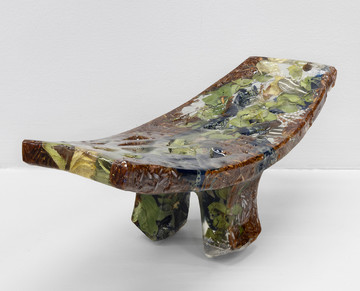
Chloé Quenum
Afiavi 2025
resin, mixed media
17 × 16 × 8 cm
“Dream Sellers” brings together eighty resin headrests, nine of them shown here, each containing fragments gathered from everyday life: beads, pieces of fabric, photographs, coins, and objects that carry personal and collective stories. These sculptures act as silent portraits, each bearing a first name, as an invitation to encounter invisible lives through the materiality of dream and sleep. Humble objects, essential in many cultures, are here reimagined as precious witnesses of memory and resistance.
Headrests exist in almost every culture around the world, but this collection draws more specifically from the forms and uses of West African headrests. These objects, far more than mere supports for the head, are artifacts rich in spiritual and cultural significance. They embody a subtle link between the sleeping body and invisible worlds, they are protectors, guardians of dreams, and thresholds between wakefulness and sleep. They support an intimate experience where the tangible and the invisible, the here and the elsewhere, the present and the past intertwine.

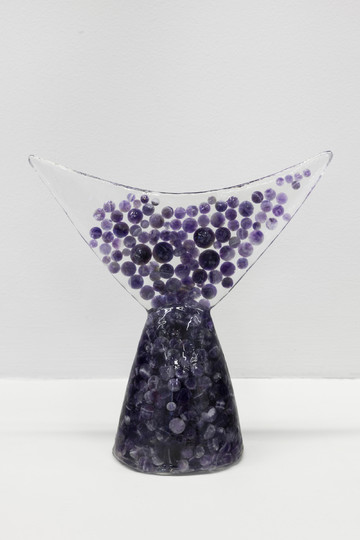
Resin offers a transparency that reveals the fragments captured within, while preserving a certain opacity, a density that invites contemplation. This dual nature reflects the complexity of the narratives they contain. These sculptures become spaces where the visible and the invisible coexist, where frozen memory unfolds through time and space. The transparency is never total, for it is about preserving the right to opacity, necessary to protect singular stories against the forces of erasure and assimilation.
This principle of opacity lies at the heart of a political and poetic thought that runs through all Chloé Quenum’s practice an approach as in “L’Heure bleue”, the glass installation proposed at the Venice Biennial, or also “WEARY”, the site specific work at Martina Simeti in 2024. The ability of these objects to keep certain stories secret is itself an act of resistance against systems that seek to homogenize, to reduce the diversity of identities and memories. Each headrest, with its unique inclusions and forms inspired by traditional models, asserts a plural, complex, and shifting identity. They are fragments of collective histories that go beyond the individual to join a shared memory.
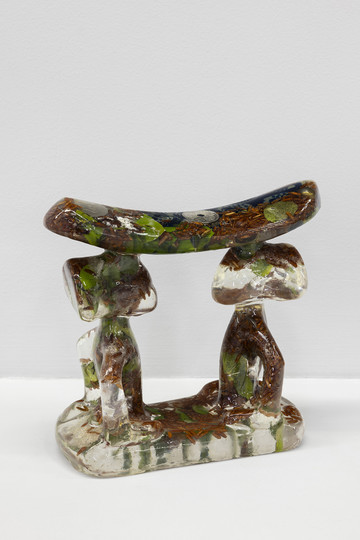
In this space between sleep and wakefulness, between body and spirit, these embodied portraits remind us that the dream
is also a political territory. Sleep becomes a moment of refuge, a time in which new ways of inhabiting the world, of thinking about freedom and memory, can be reinvented. Through this collection, sleep is not reduced to a biological pause but opens as a sensitive and political experience, a suspended time in which oppression can momentarily be set aside to make room for imagination, resistance, and transformation.
These works are part of a broader artistic practice that questions the invisible forms of power and the mechanisms of erasure that affect bodies, histories, and identities. By reconfiguring objects that carry memory, by extracting them from their original context, these gestures invite us to rethink the links between past and present, between the individual and the collective, between the visible and the invisible.
Each headrest is a unique piece that embodies this tension and richness. They invite a sensory and political experience, an engagement that is both poetic and concrete. Their uniqueness makes them singular objects where neither reproduction nor repetition can exist, objects that continuously recount and give life to invisible stories.
Whether working with blown glass or liquid pixels, Quenum continues investigating how identity resists perfect reproduction, how loss can generate new forms of creation.
Her digital collages become another medium through which memory flows and transforms each layer of superimposed imagery creating new territories of meaning.
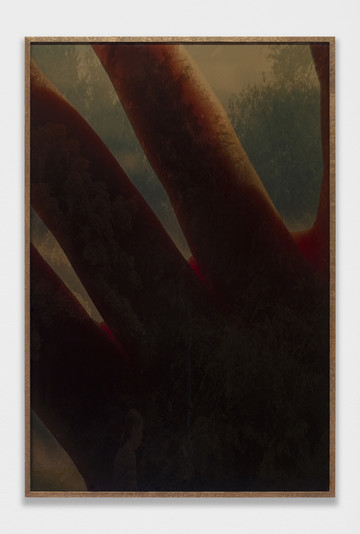
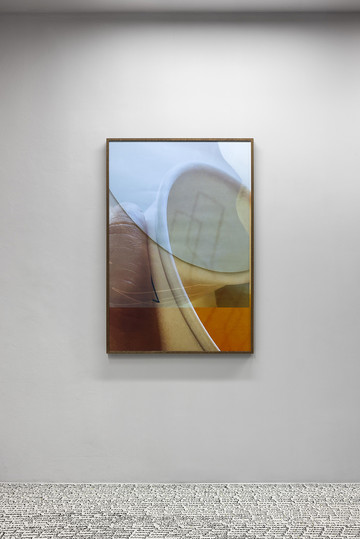
Chloé Quenum
Délivrances 2024
digital collage, inkjet print on matte paper
120 × 80 cm

Davide Stucchi’s artistic research makes use of minimal interventions, often ones of subtraction or alteration, on preexisting materials. His installations evoke absent bodies that interact with vulnerable objects in the intimacy of spaces sculpted by intimate and private feelings and memories. The comparison with external realities such as fashion, advertising, and the domestic environment in Stucchi’s works, serves as an expedient for the deconstruction of social and gender representations.
With a certain sense of irreverence without narrative justifications, Stucchi’s works are on the threshold of the image without taking it for real, on that point that crosses the plot of the experience remaining dubious and always distant. His is a proposal for the deconstruction of the macho ideal, also through a given methodology, not in the productive effort. Bodies and objects become desirable and desiring subjects, sensual elements that come alive and invite close relationships and new gestures.
His work has been shown in solo and collective exhibitions by international institutions including Centro Pecci, Prato (2025), Grazer, Kunstverein, Graz (2023), MUSEION, Bozen (2024), MACRO Rome (2021), Stadtgalerie, Bern (2020), Fondazione Sandretto Re Rebaudengo, Turin (2018), Quadriennale di Roma, Palazzo Delle Esposizioni, Rome (2016 and 2020). Davide Stucchi was resident fellow at the Triangle, Marseille (2016), Cité internationale des Arts, Paris (2013), Fondazione Pastificio Cerere per l’Arte Contemporanea, Rome (2013).
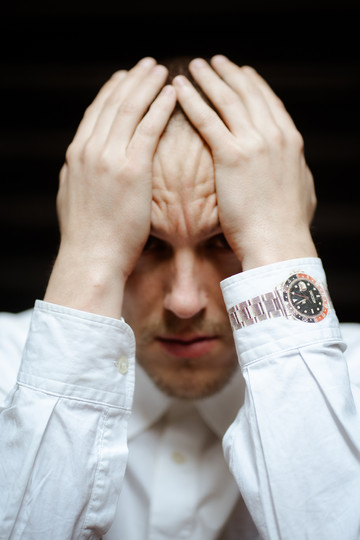
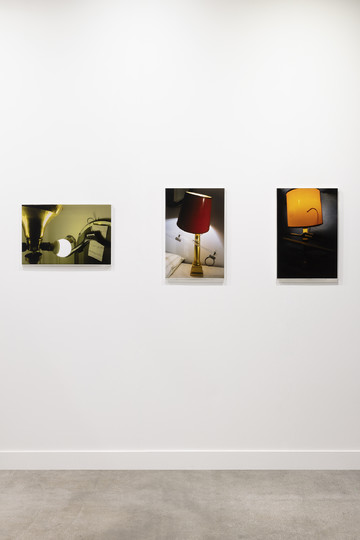
In the medieval period, before the word ‘artist’ existed, the craftspeople who made the decorative lettering, detailing, and imaging on manuscripts were called limners, meaning illuminator, from the Latin lumen. The job of the artist, in other words, was to bring light to the object. To turn it on.
In Davide Stucchi’s practice, photogoraphy - its ecstatic, narcissistic, and obsessor aspect - sometimes dialogues with the sculptural object, becoming the story of a physical relationship. The photographic shot and the sculptural body exercise a reciprocal influence, evoking the sense of a non-Euclidean space that mingles digital nuances with a certain degree of handicraft.
With this series of domestic, petit-bourgeois, and familiar imaginaries, Stucchi dwells on the generational resonances of the objects he has collected.
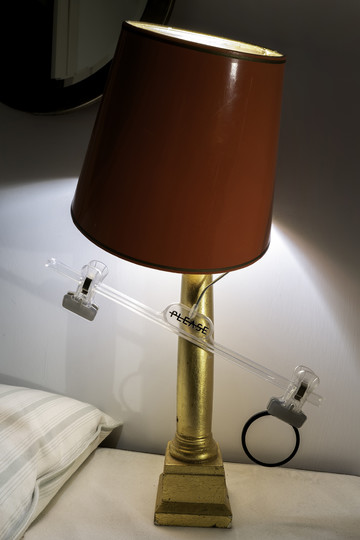
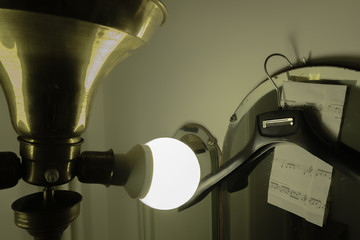
Davide Stucchi (in collaboration with Mattia Ruffolo)
Clothes Anger (P.), 2021
Fine art print on Canson Platine fiber
60,5 × 40,5 × 1,8 cm
ed. 3 + 1 AP
A gang of luminous objects, capable of unsettling the most basic notions of display, artistic categories, affect, function,
desire, and safety, slyly recalls the analog fetishism of certain objets surréalistes, Félix González-Torres’s Light Strings, perhaps Guillaume Bijl’s Lusterie Média, or more indirectly, Nanda Vigo’s Light Projects.
Stucchi’s attunement to the way that objects carry and convey life forces, characters, and stories was embedded in his artistic training. Stucchi recalls important exercises that the older artist set for Stucchi’s class regarding the pensieri dell’ opera (the thoughts of the work), in which students were asked to describe what they believed the works of art that they were making were thinking, or would have to say, on three different subjects: what were the artwork’s critical thoughts, what were its ethical thoughts, and what were its affectionate or amorous thoughts?


“Persona”, “Amen”, “Please”, these talking objects testify once again of the recurrent witty use of language in Stucchi’s
work.
As in the show at Martina Simeti, “6, Corso Via”, where presence returned in traces. The title itself unfolds in Italian as a layered linguistic play: 6 means both “six” and “you are,” corso is both “avenue” and “running,” and via is both “street” and “away.” The address becomes a phrase you ran away. A perfect metaphor for displacement or, better, an addressed displacement.
The switch is conceived as a kind of fetish object: a device of activation and deactivation for meanings already in tension (clash, semantic short-circuits). Stucchi takes what is a banal, almost invisible domestic object, and repositions it as a site of expectancy, desire, and relational tension.
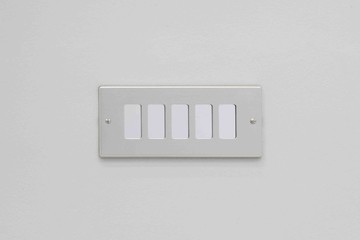
Our hands are the sensory place that we first meet the world, and make connection with it. One can hold hands with another person, but when we handle an object, might that be akin to holding its hand? It wants to be touched, it wants you to know its history, it wants to be more equal with us.
Davide Stucchi
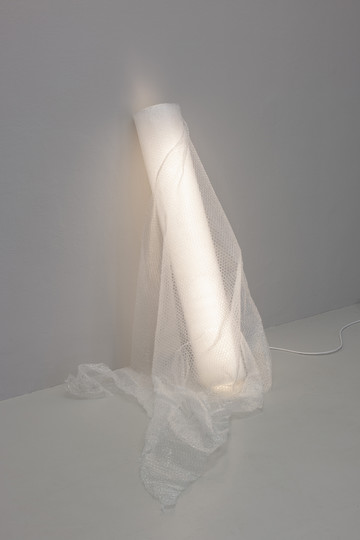
In Stucchi’s sculptures LED strip lights are either “shy” (hiding behind a shade that completely conceals the raw light of the bulb) or “confident” (covered only in a piece of fabric like a sheer gauze).
Absence, for me, is about calibrating the density of presence. Presence doesn’t have to be heavy or literal; it can exist in something minimal, even intangible. I’m not interested in a melancholic narrative of “I miss something, so I create.”
Instead, I prefer to create space within space, to see it not as empty but as free, like a pause, a breath between two words. This space doesn’t need to follow the rules of what surrounds it. It can hold a suspension of belief, a moment of openness. It’s more a charged void, a sub-space that activates perception and dialogue.
Davide Stucchi
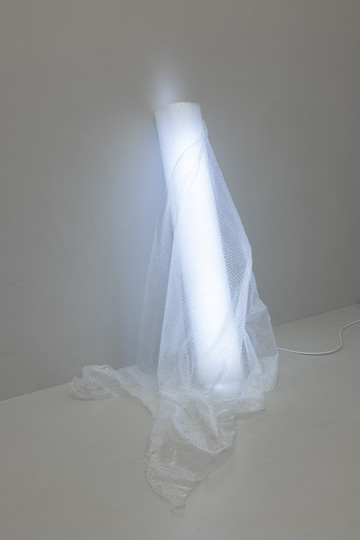
Davide Stucchi
Confident LED IV, 2025
White light, cable, plug, electrical outlet, bubble wrap
Dimensions variable
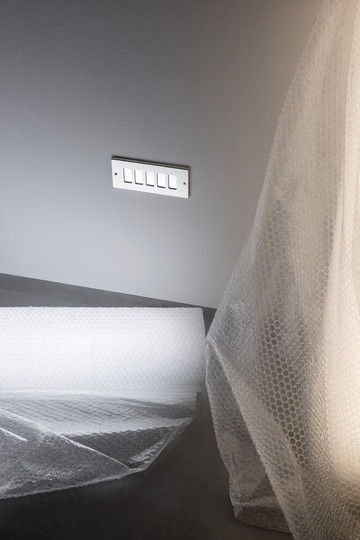
In many of these sculptures, one thing learns to accommodate another. In fact, several of Stucchi’s more recent sculptures
foreground partnerships and ties between object characters, rather than a narrative of a single object.
In the artist’s own words, these sculptures ask what it means for one thing to sustain another, and are created in a way that emphasizes the modulation of one person’s character, will, or body, in relation to another. Where two objects find a way to co-exist, it is through negotiation, consent, affirmation.
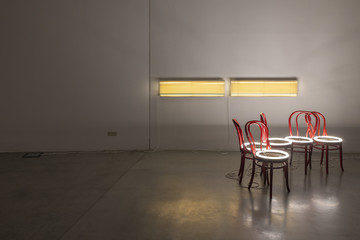
Davide Stucchi
Light Ligths, 2025
Installation view, Centro Pecci, Prato
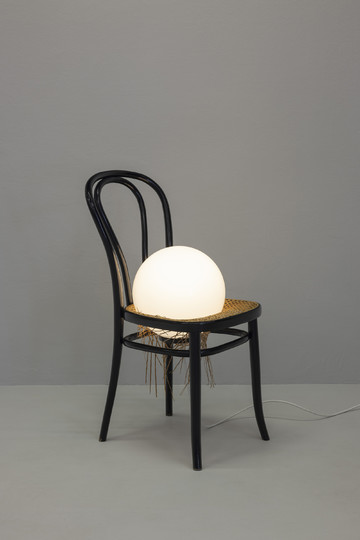
Stucchi insists on the generational resonances of the objects he has collected. There is an emotional transference in the broken Thonet chair that could have belonged to his grandparents’ or parents’ home: antifunctional, non-signifying, and therefore all the more poignant.
A middle-class icon, Stucchi understands Thonet chairs as also embodying certain archetypal characteristics of the bourgeois families who own them, such as the spoiled child or an uptight mother, with tensions that end in the base of the chair being trashed.
You talk, I listen
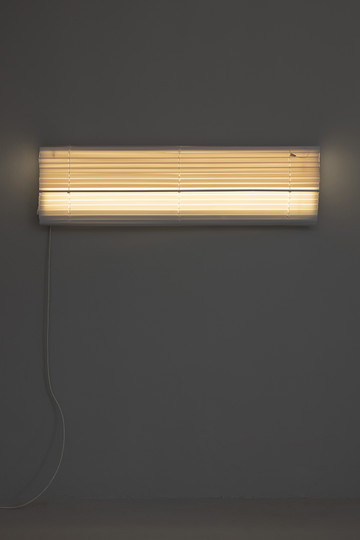
Employing illumination with lamps and lightbulbs most directly triggers a conferring of life into an object, due to the way that the introduction of electricity and illumination are so closely tied to the human conception of life.

Davide Stucchi
Exuberant Led, 2025
Led panel, pvc venetian blinds, cable, electric plug
10 × 120 × 31 cm

Davide Stucchi
Showroom lights, 2012
Photosensitive paper
17.5 x 12.5 cm each
In the project “I’ll not be your mirror!”curated by Francesco Garutti/Yann Chateigné Tytelman and commissioned by Dior, the artist juxtaposed the fashion world with pioneering techniques from the history of photography such as pinhole cameras and photograms - or rayograms, as Man Ray called them in the early Twenties.
Working within the Dior boutique, Stucchi used light-sensitive paper to reproduce the patterns of some of its objects and accessories on a two-dimensional surface.

Martina Simeti, Paris Internationale 2025 | Chloè Quenum and Davide Stucchi

